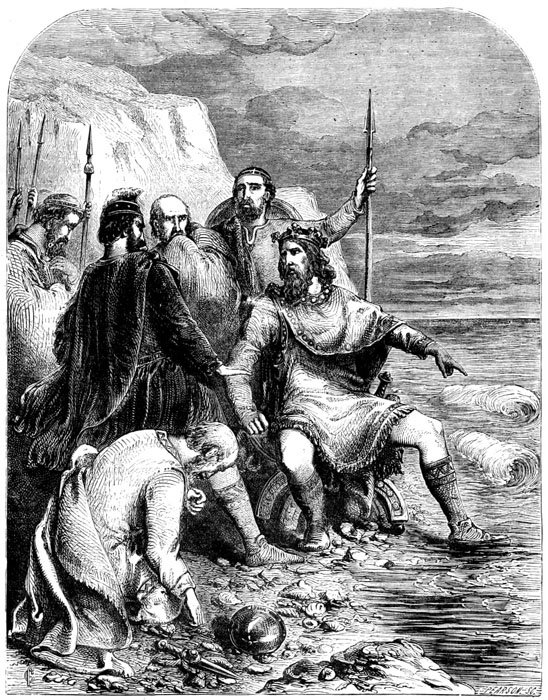King Cnut the Great
King Cnut the Great was the second son of Sweyn Forkbeard and Gunnhilde of Poland. He served in his father’s army as a teenager in England, gaining valuable experience that would later serve him well. Cnut was an excellent leader, with both the ferocity of a powerful warlord and the maturity of a great king. His determination and military might enabled him and his family to become kings of England and Scandinavia, in one of the great dynasties of the time. But, as with many before him, his power and empire would not last.
| Born | 995 |
| Parents | Sweyn Forkbeard & Gunnhilde of Poland |
| Married | Aelfgifu of Northampton & Emma of Normandy |
| Children | 5, inc Harold I Harefoot and Harthacnut |
| Died | 12 November 1035, Shaftesbury, Dorset, buried at Winchester Cathedral (40) |
| Reign | 1016 - 1035 (18) |
| Crowned | 6 January 1017, Old St Paul’s Cathedral (22) |
| Predecessor | Edmund II Ironside |
| Successor | Harold I Harefoot (son) |
| House | Denmark |
Life Events of King Cnut
995
Cnut is born to Sweyn Forkbeard and Gunnhilde of Poland.
1014
Cnut’s father, Sweyn Forkbeard dies. Cnut takes command of the army, and is supported by local nobility. Aethelred’s counsellors defect and return to his cause. Aethelred returns from Normandy, and leads a large army at Lindsey. Cnut retreats to Denmark, but savagely mutilates his hostages, and dumps them ashore at Sandwich.
1015
Cnut returns to England in September to declare his claim to the throne. He tactically marries Aelfgifu, Daughter of Ealdorman Aelfhelm of Northumbria and together they have two sons.
1015
Cnut lands at Sandwich, and then sails on to Wareham and invades Dorset and Wiltshire. Aethelred’s army is paralysed, through lack of leadership and Aethelred’s ill health, while Edmund II Ironside raises forces in Mercia. Cnut receives insider support from Earl Eadric of Mercia, and earns recognition as king of Wessex.
1016
Edmund Ironside, who is avoiding open battle with Cnut, while his forces are lacking in strength, wins support of Earl Uhtred of Northumbria. But Cnut soon marches north and forces Uhtred’s submission, and executes him anyway. Cnut then marches south to London, to face Aethelred, but the Saxon king dies before he gets there. Edmund manages to hold out against Cnut’s army in London and Wessex, and defeats Cnut at Brentford. Cnut’s army flees to their ships in Sheppey.
1016
On the 18th October at the Battle of Assandun (Ashingdon, Essex), Cnut is victorious. His victory is helped by the treacherous Earl Eadric, who intentionally deserted Edmund. Cnut pursues Edmund to the Severn Valley, where a treaty was signed on Ola’s Island, which leaves Wessex to Edmund, and the rest of England to Cnut.
1016
On the 28th November, Edmund II Ironside dies at Oxford. Cnut succeeds him and kills Edmund’s infant heirs. Earl Eadric is also executed.
1017
Cnut sets aside his wife, Aelfgifu, and marries Emma of Normandy, Aethelred’s widow, who had fled to Normandy.
1018
Cnut raises £72,000 in taxes to maintain his huge army, and uses it to deal with local rebels. His personal bodyguards form the beginnings of the housecarls, which would later fight for Harold II. Cnut maintains much of the senior landholding class, following previous Anglo-Saxon customs.
1018
Harold of Denmark dies childless. Cnut departs England and makes his son Harthacnut governor of Denmark.
1020
Cnut gives part of Wessex to the Godwin family. The Earl Godwin in turn marries Cnut’s sister-in-law, Goda. Cnut continues traditional English kingship, re-issuing old laws, consulting with Archbishop Wulfstan of York and upholding law and order.
1026
Cnut leads a failed invasion of Sweden, at the Battle of Holy River.
1027
Cnut goes on a pilgrimage to Rome, where Emperor Conrad treats him as an equal. Cnut’s daughter Gunnhilde marries Emperor Conrad’s son.
1028
Norway falls to Cnut.
1030
Norway’s exiled King St Olaf is killed at the Battle of Stiklestad. Cnut’s elder son Sweyn now rules Norway. Cnut becomes the head of the hugely powerful family of monarchies across England and Scandinavia.
1031
Cnut invades Scotland addressing a very much neglected northern border. Malcolm II avoids the battle, as his smaller army cannot compete with Cnut’s might. Terms of peace are agreed instead and Malcolm accepts Cnut’s overlordship.
1035
On the 12th November Cnut dies in Shaftesbury, while his favoured heir Harthacnut, is still in Denmark. The English nobility are unsure which of Cnut’s sons should succeed. A stand-off follows and Cnut’s eldest son Harold I Harefoot, eventually wins the succession to become king of England.
Interesting Facts About King Cnut the Great
Split Rule
After the defeat at the Battle of Assandun, Cnut agreed to split the rule of England with Edmund, possibly out of respect. The treaty stated that when one of them dies, the other would take the whole kingdom.One King to Rule them all
King Cnut ruled a huge empire as king of England, Denmark, Norway, and parts of Sweden.
Holding back the Tide
Legend has it that King Cnut the Great tried to convince his nobles that he was no God. He placed his throne on the shoreline, and ordered the tide not to rise, so that he and his nobles would remain dry. Needless to say, they did not remain dry, and therefore proved that he was a mere mortal!
Image Source: Cassell’s Illustrated History of England
Battles Fought by King Cnut the Great
Battle of Assandun
In 1016, Cnut the Great and his huge invasion force, won a decisive victory over Edmund II Ironside at Ashingdon, Essex.
FAQs About the King
Was Cnut the Great a Viking?
Yes he was, and extremely powerful. He became king of Scandinavia at the same time as king of England, England's second Viking king. He also had overlordship of Scotland.How did Cnut the Great become king of England?
Cnut the Great defeated Edmund II Ironside at the Battle of Assandun, and took most of England. After Edmund's death, Cnut became king of all England.Why did Cnut the Great marry Emma of Normandy?
Cnut needed to marry Emma of Normandy to prevent her heirs from becoming a threat to his crown.
Related Videos To The King
The Danish Kings of England



